Quality Benchmarks Integration into Clinical Decision Making for NPs
VerifiedAdded on 2023/01/03
|8
|1896
|96
Report
AI Summary
This report evaluates practice patterns against national benchmarks to determine variances in clinical outcomes and population trends. It investigates and compares two national Quality 1 benchmarks, such as HEDIS measures, used as scorecards in healthcare, focusing on their variances and population focus. The report also assesses the success of these benchmarks in improving and maintaining quality care and discusses the role of the DNP-prepared nurse in developing and implementing quality benchmarks in healthcare settings. The analysis includes a review of relevant literature and provides conclusions based on a scholarly appraisal of the quality benchmarks, with specific attention to the integration of motivational interviewing to improve appointment rates for underserved patients in a free clinic setting. The report emphasizes the importance of benchmarking for quality improvement through healthy competition and the identification of areas of excellence, while also considering ethical implications.

Running head: PRACTICE PATTERNS AGAINST NATIONAL BENCHMARKS 1
Practice Patterns Against National Benchmarks
Student’s Name
Institutional Affiliation
Practice Patterns Against National Benchmarks
Student’s Name
Institutional Affiliation
Paraphrase This Document
Need a fresh take? Get an instant paraphrase of this document with our AI Paraphraser
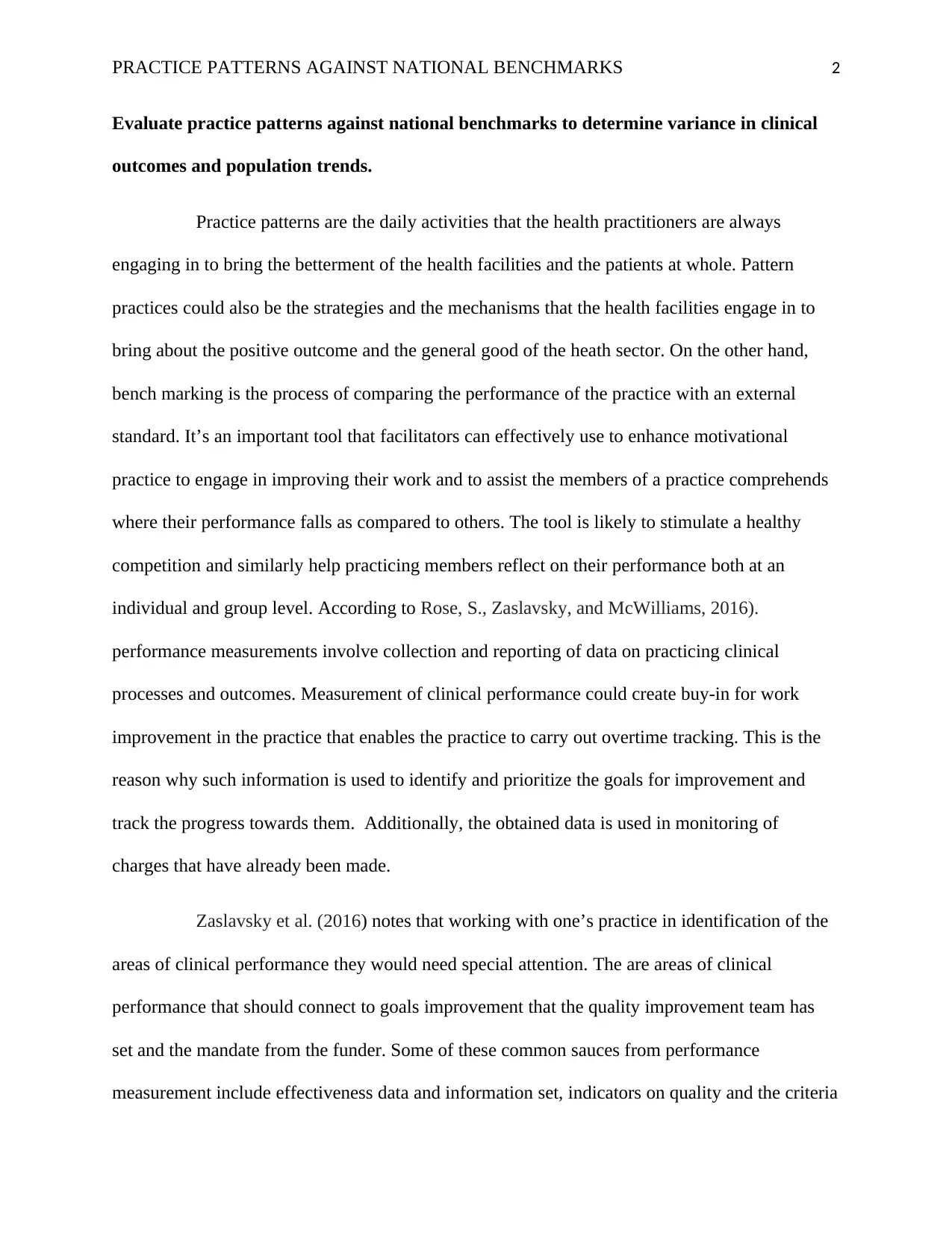
PRACTICE PATTERNS AGAINST NATIONAL BENCHMARKS 2
Evaluate practice patterns against national benchmarks to determine variance in clinical
outcomes and population trends.
Practice patterns are the daily activities that the health practitioners are always
engaging in to bring the betterment of the health facilities and the patients at whole. Pattern
practices could also be the strategies and the mechanisms that the health facilities engage in to
bring about the positive outcome and the general good of the heath sector. On the other hand,
bench marking is the process of comparing the performance of the practice with an external
standard. It’s an important tool that facilitators can effectively use to enhance motivational
practice to engage in improving their work and to assist the members of a practice comprehends
where their performance falls as compared to others. The tool is likely to stimulate a healthy
competition and similarly help practicing members reflect on their performance both at an
individual and group level. According to Rose, S., Zaslavsky, and McWilliams, 2016).
performance measurements involve collection and reporting of data on practicing clinical
processes and outcomes. Measurement of clinical performance could create buy-in for work
improvement in the practice that enables the practice to carry out overtime tracking. This is the
reason why such information is used to identify and prioritize the goals for improvement and
track the progress towards them. Additionally, the obtained data is used in monitoring of
charges that have already been made.
Zaslavsky et al. (2016) notes that working with one’s practice in identification of the
areas of clinical performance they would need special attention. The are areas of clinical
performance that should connect to goals improvement that the quality improvement team has
set and the mandate from the funder. Some of these common sauces from performance
measurement include effectiveness data and information set, indicators on quality and the criteria
Evaluate practice patterns against national benchmarks to determine variance in clinical
outcomes and population trends.
Practice patterns are the daily activities that the health practitioners are always
engaging in to bring the betterment of the health facilities and the patients at whole. Pattern
practices could also be the strategies and the mechanisms that the health facilities engage in to
bring about the positive outcome and the general good of the heath sector. On the other hand,
bench marking is the process of comparing the performance of the practice with an external
standard. It’s an important tool that facilitators can effectively use to enhance motivational
practice to engage in improving their work and to assist the members of a practice comprehends
where their performance falls as compared to others. The tool is likely to stimulate a healthy
competition and similarly help practicing members reflect on their performance both at an
individual and group level. According to Rose, S., Zaslavsky, and McWilliams, 2016).
performance measurements involve collection and reporting of data on practicing clinical
processes and outcomes. Measurement of clinical performance could create buy-in for work
improvement in the practice that enables the practice to carry out overtime tracking. This is the
reason why such information is used to identify and prioritize the goals for improvement and
track the progress towards them. Additionally, the obtained data is used in monitoring of
charges that have already been made.
Zaslavsky et al. (2016) notes that working with one’s practice in identification of the
areas of clinical performance they would need special attention. The are areas of clinical
performance that should connect to goals improvement that the quality improvement team has
set and the mandate from the funder. Some of these common sauces from performance
measurement include effectiveness data and information set, indicators on quality and the criteria
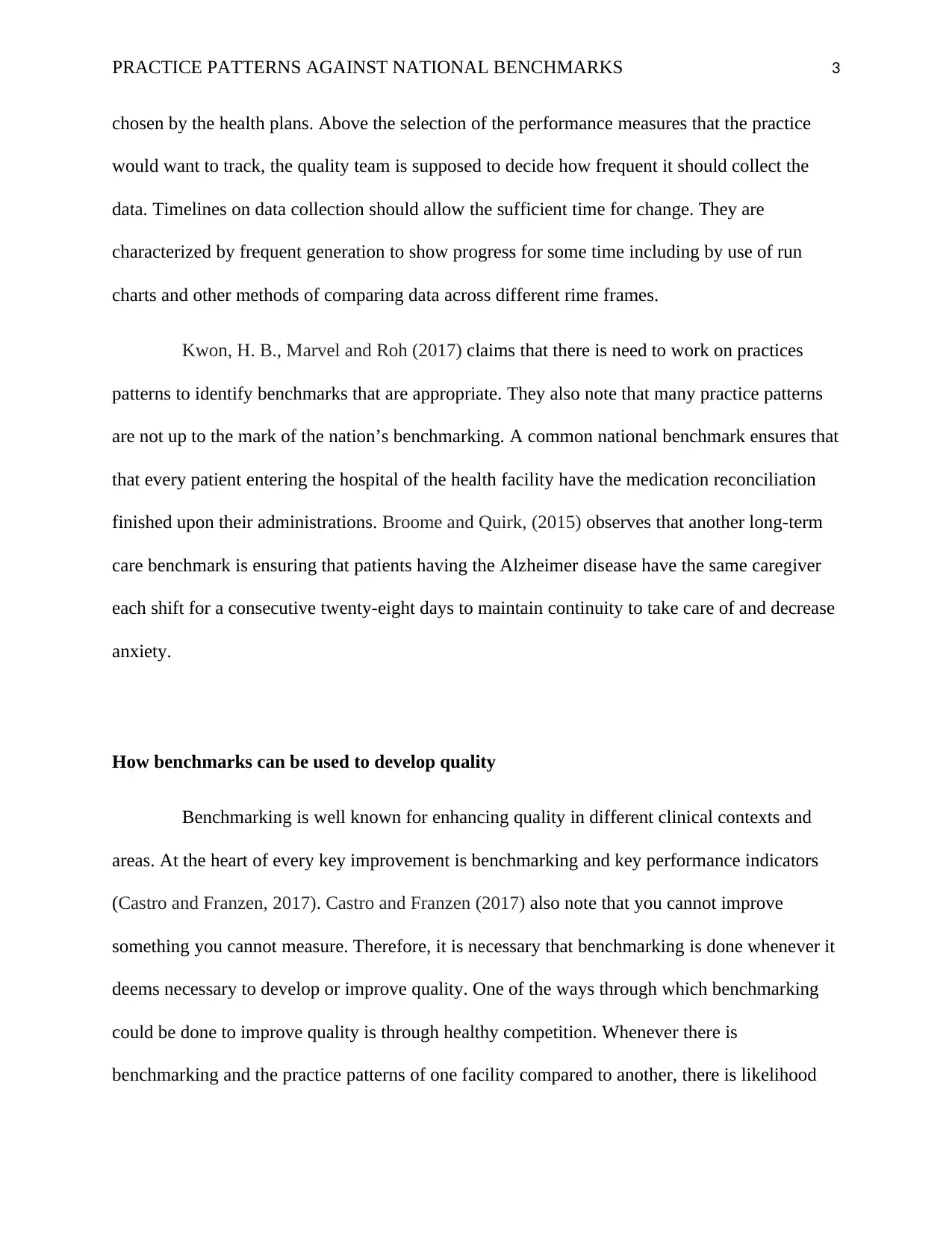
PRACTICE PATTERNS AGAINST NATIONAL BENCHMARKS 3
chosen by the health plans. Above the selection of the performance measures that the practice
would want to track, the quality team is supposed to decide how frequent it should collect the
data. Timelines on data collection should allow the sufficient time for change. They are
characterized by frequent generation to show progress for some time including by use of run
charts and other methods of comparing data across different rime frames.
Kwon, H. B., Marvel and Roh (2017) claims that there is need to work on practices
patterns to identify benchmarks that are appropriate. They also note that many practice patterns
are not up to the mark of the nation’s benchmarking. A common national benchmark ensures that
that every patient entering the hospital of the health facility have the medication reconciliation
finished upon their administrations. Broome and Quirk, (2015) observes that another long-term
care benchmark is ensuring that patients having the Alzheimer disease have the same caregiver
each shift for a consecutive twenty-eight days to maintain continuity to take care of and decrease
anxiety.
How benchmarks can be used to develop quality
Benchmarking is well known for enhancing quality in different clinical contexts and
areas. At the heart of every key improvement is benchmarking and key performance indicators
(Castro and Franzen, 2017). Castro and Franzen (2017) also note that you cannot improve
something you cannot measure. Therefore, it is necessary that benchmarking is done whenever it
deems necessary to develop or improve quality. One of the ways through which benchmarking
could be done to improve quality is through healthy competition. Whenever there is
benchmarking and the practice patterns of one facility compared to another, there is likelihood
chosen by the health plans. Above the selection of the performance measures that the practice
would want to track, the quality team is supposed to decide how frequent it should collect the
data. Timelines on data collection should allow the sufficient time for change. They are
characterized by frequent generation to show progress for some time including by use of run
charts and other methods of comparing data across different rime frames.
Kwon, H. B., Marvel and Roh (2017) claims that there is need to work on practices
patterns to identify benchmarks that are appropriate. They also note that many practice patterns
are not up to the mark of the nation’s benchmarking. A common national benchmark ensures that
that every patient entering the hospital of the health facility have the medication reconciliation
finished upon their administrations. Broome and Quirk, (2015) observes that another long-term
care benchmark is ensuring that patients having the Alzheimer disease have the same caregiver
each shift for a consecutive twenty-eight days to maintain continuity to take care of and decrease
anxiety.
How benchmarks can be used to develop quality
Benchmarking is well known for enhancing quality in different clinical contexts and
areas. At the heart of every key improvement is benchmarking and key performance indicators
(Castro and Franzen, 2017). Castro and Franzen (2017) also note that you cannot improve
something you cannot measure. Therefore, it is necessary that benchmarking is done whenever it
deems necessary to develop or improve quality. One of the ways through which benchmarking
could be done to improve quality is through healthy competition. Whenever there is
benchmarking and the practice patterns of one facility compared to another, there is likelihood
⊘ This is a preview!⊘
Do you want full access?
Subscribe today to unlock all pages.

Trusted by 1+ million students worldwide
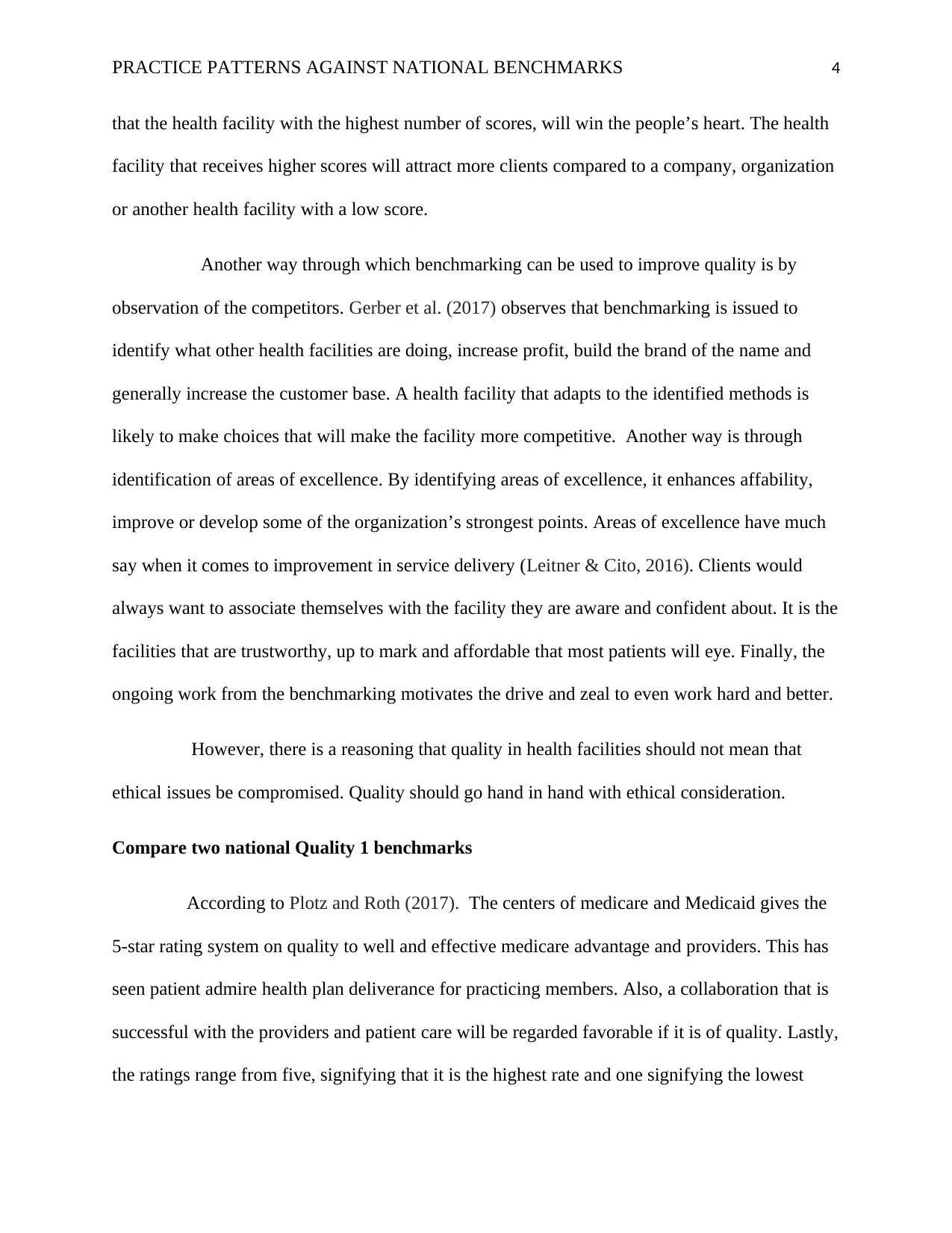
PRACTICE PATTERNS AGAINST NATIONAL BENCHMARKS 4
that the health facility with the highest number of scores, will win the people’s heart. The health
facility that receives higher scores will attract more clients compared to a company, organization
or another health facility with a low score.
Another way through which benchmarking can be used to improve quality is by
observation of the competitors. Gerber et al. (2017) observes that benchmarking is issued to
identify what other health facilities are doing, increase profit, build the brand of the name and
generally increase the customer base. A health facility that adapts to the identified methods is
likely to make choices that will make the facility more competitive. Another way is through
identification of areas of excellence. By identifying areas of excellence, it enhances affability,
improve or develop some of the organization’s strongest points. Areas of excellence have much
say when it comes to improvement in service delivery (Leitner & Cito, 2016). Clients would
always want to associate themselves with the facility they are aware and confident about. It is the
facilities that are trustworthy, up to mark and affordable that most patients will eye. Finally, the
ongoing work from the benchmarking motivates the drive and zeal to even work hard and better.
However, there is a reasoning that quality in health facilities should not mean that
ethical issues be compromised. Quality should go hand in hand with ethical consideration.
Compare two national Quality 1 benchmarks
According to Plotz and Roth (2017). The centers of medicare and Medicaid gives the
5-star rating system on quality to well and effective medicare advantage and providers. This has
seen patient admire health plan deliverance for practicing members. Also, a collaboration that is
successful with the providers and patient care will be regarded favorable if it is of quality. Lastly,
the ratings range from five, signifying that it is the highest rate and one signifying the lowest
that the health facility with the highest number of scores, will win the people’s heart. The health
facility that receives higher scores will attract more clients compared to a company, organization
or another health facility with a low score.
Another way through which benchmarking can be used to improve quality is by
observation of the competitors. Gerber et al. (2017) observes that benchmarking is issued to
identify what other health facilities are doing, increase profit, build the brand of the name and
generally increase the customer base. A health facility that adapts to the identified methods is
likely to make choices that will make the facility more competitive. Another way is through
identification of areas of excellence. By identifying areas of excellence, it enhances affability,
improve or develop some of the organization’s strongest points. Areas of excellence have much
say when it comes to improvement in service delivery (Leitner & Cito, 2016). Clients would
always want to associate themselves with the facility they are aware and confident about. It is the
facilities that are trustworthy, up to mark and affordable that most patients will eye. Finally, the
ongoing work from the benchmarking motivates the drive and zeal to even work hard and better.
However, there is a reasoning that quality in health facilities should not mean that
ethical issues be compromised. Quality should go hand in hand with ethical consideration.
Compare two national Quality 1 benchmarks
According to Plotz and Roth (2017). The centers of medicare and Medicaid gives the
5-star rating system on quality to well and effective medicare advantage and providers. This has
seen patient admire health plan deliverance for practicing members. Also, a collaboration that is
successful with the providers and patient care will be regarded favorable if it is of quality. Lastly,
the ratings range from five, signifying that it is the highest rate and one signifying the lowest
Paraphrase This Document
Need a fresh take? Get an instant paraphrase of this document with our AI Paraphraser
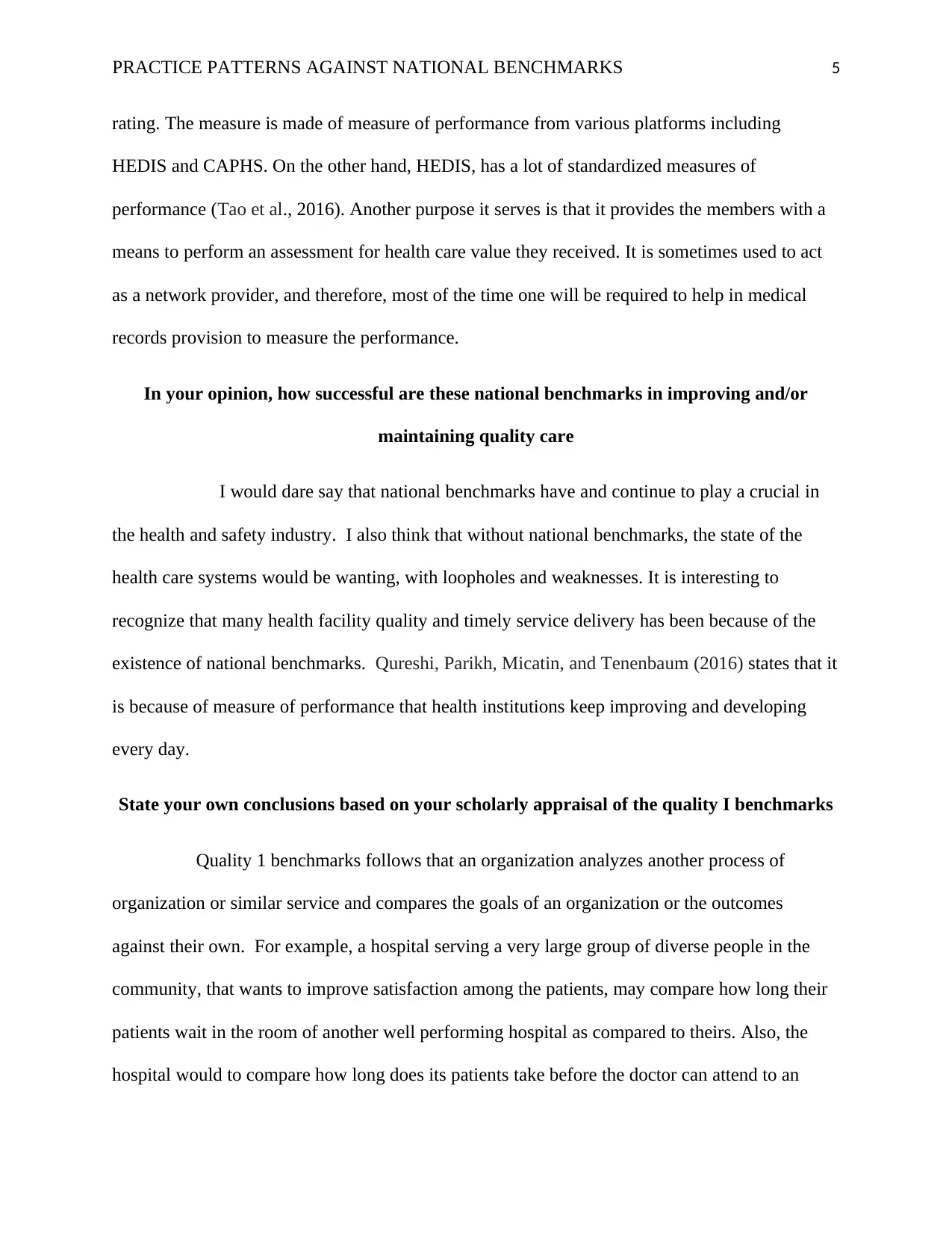
PRACTICE PATTERNS AGAINST NATIONAL BENCHMARKS 5
rating. The measure is made of measure of performance from various platforms including
HEDIS and CAPHS. On the other hand, HEDIS, has a lot of standardized measures of
performance (Tao et al., 2016). Another purpose it serves is that it provides the members with a
means to perform an assessment for health care value they received. It is sometimes used to act
as a network provider, and therefore, most of the time one will be required to help in medical
records provision to measure the performance.
In your opinion, how successful are these national benchmarks in improving and/or
maintaining quality care
I would dare say that national benchmarks have and continue to play a crucial in
the health and safety industry. I also think that without national benchmarks, the state of the
health care systems would be wanting, with loopholes and weaknesses. It is interesting to
recognize that many health facility quality and timely service delivery has been because of the
existence of national benchmarks. Qureshi, Parikh, Micatin, and Tenenbaum (2016) states that it
is because of measure of performance that health institutions keep improving and developing
every day.
State your own conclusions based on your scholarly appraisal of the quality I benchmarks
Quality 1 benchmarks follows that an organization analyzes another process of
organization or similar service and compares the goals of an organization or the outcomes
against their own. For example, a hospital serving a very large group of diverse people in the
community, that wants to improve satisfaction among the patients, may compare how long their
patients wait in the room of another well performing hospital as compared to theirs. Also, the
hospital would to compare how long does its patients take before the doctor can attend to an
rating. The measure is made of measure of performance from various platforms including
HEDIS and CAPHS. On the other hand, HEDIS, has a lot of standardized measures of
performance (Tao et al., 2016). Another purpose it serves is that it provides the members with a
means to perform an assessment for health care value they received. It is sometimes used to act
as a network provider, and therefore, most of the time one will be required to help in medical
records provision to measure the performance.
In your opinion, how successful are these national benchmarks in improving and/or
maintaining quality care
I would dare say that national benchmarks have and continue to play a crucial in
the health and safety industry. I also think that without national benchmarks, the state of the
health care systems would be wanting, with loopholes and weaknesses. It is interesting to
recognize that many health facility quality and timely service delivery has been because of the
existence of national benchmarks. Qureshi, Parikh, Micatin, and Tenenbaum (2016) states that it
is because of measure of performance that health institutions keep improving and developing
every day.
State your own conclusions based on your scholarly appraisal of the quality I benchmarks
Quality 1 benchmarks follows that an organization analyzes another process of
organization or similar service and compares the goals of an organization or the outcomes
against their own. For example, a hospital serving a very large group of diverse people in the
community, that wants to improve satisfaction among the patients, may compare how long their
patients wait in the room of another well performing hospital as compared to theirs. Also, the
hospital would to compare how long does its patients take before the doctor can attend to an

PRACTICE PATTERNS AGAINST NATIONAL BENCHMARKS 6
emergency case. In so doing, quality and service delivery will be greatly improved because they
learned from other individuals like them.
emergency case. In so doing, quality and service delivery will be greatly improved because they
learned from other individuals like them.
⊘ This is a preview!⊘
Do you want full access?
Subscribe today to unlock all pages.

Trusted by 1+ million students worldwide
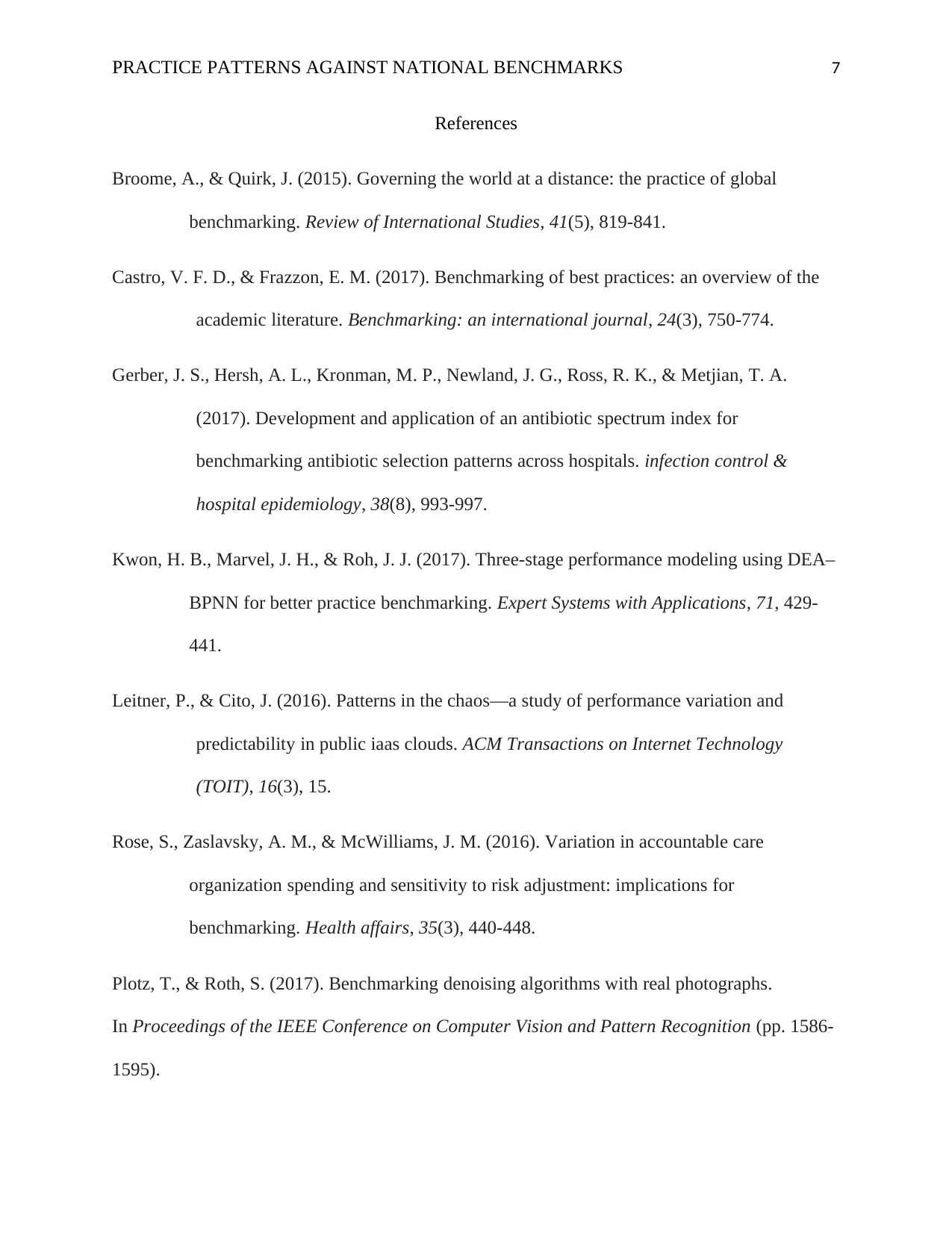
PRACTICE PATTERNS AGAINST NATIONAL BENCHMARKS 7
References
Broome, A., & Quirk, J. (2015). Governing the world at a distance: the practice of global
benchmarking. Review of International Studies, 41(5), 819-841.
Castro, V. F. D., & Frazzon, E. M. (2017). Benchmarking of best practices: an overview of the
academic literature. Benchmarking: an international journal, 24(3), 750-774.
Gerber, J. S., Hersh, A. L., Kronman, M. P., Newland, J. G., Ross, R. K., & Metjian, T. A.
(2017). Development and application of an antibiotic spectrum index for
benchmarking antibiotic selection patterns across hospitals. infection control &
hospital epidemiology, 38(8), 993-997.
Kwon, H. B., Marvel, J. H., & Roh, J. J. (2017). Three-stage performance modeling using DEA–
BPNN for better practice benchmarking. Expert Systems with Applications, 71, 429-
441.
Leitner, P., & Cito, J. (2016). Patterns in the chaos—a study of performance variation and
predictability in public iaas clouds. ACM Transactions on Internet Technology
(TOIT), 16(3), 15.
Rose, S., Zaslavsky, A. M., & McWilliams, J. M. (2016). Variation in accountable care
organization spending and sensitivity to risk adjustment: implications for
benchmarking. Health affairs, 35(3), 440-448.
Plotz, T., & Roth, S. (2017). Benchmarking denoising algorithms with real photographs.
In Proceedings of the IEEE Conference on Computer Vision and Pattern Recognition (pp. 1586-
1595).
References
Broome, A., & Quirk, J. (2015). Governing the world at a distance: the practice of global
benchmarking. Review of International Studies, 41(5), 819-841.
Castro, V. F. D., & Frazzon, E. M. (2017). Benchmarking of best practices: an overview of the
academic literature. Benchmarking: an international journal, 24(3), 750-774.
Gerber, J. S., Hersh, A. L., Kronman, M. P., Newland, J. G., Ross, R. K., & Metjian, T. A.
(2017). Development and application of an antibiotic spectrum index for
benchmarking antibiotic selection patterns across hospitals. infection control &
hospital epidemiology, 38(8), 993-997.
Kwon, H. B., Marvel, J. H., & Roh, J. J. (2017). Three-stage performance modeling using DEA–
BPNN for better practice benchmarking. Expert Systems with Applications, 71, 429-
441.
Leitner, P., & Cito, J. (2016). Patterns in the chaos—a study of performance variation and
predictability in public iaas clouds. ACM Transactions on Internet Technology
(TOIT), 16(3), 15.
Rose, S., Zaslavsky, A. M., & McWilliams, J. M. (2016). Variation in accountable care
organization spending and sensitivity to risk adjustment: implications for
benchmarking. Health affairs, 35(3), 440-448.
Plotz, T., & Roth, S. (2017). Benchmarking denoising algorithms with real photographs.
In Proceedings of the IEEE Conference on Computer Vision and Pattern Recognition (pp. 1586-
1595).
Paraphrase This Document
Need a fresh take? Get an instant paraphrase of this document with our AI Paraphraser
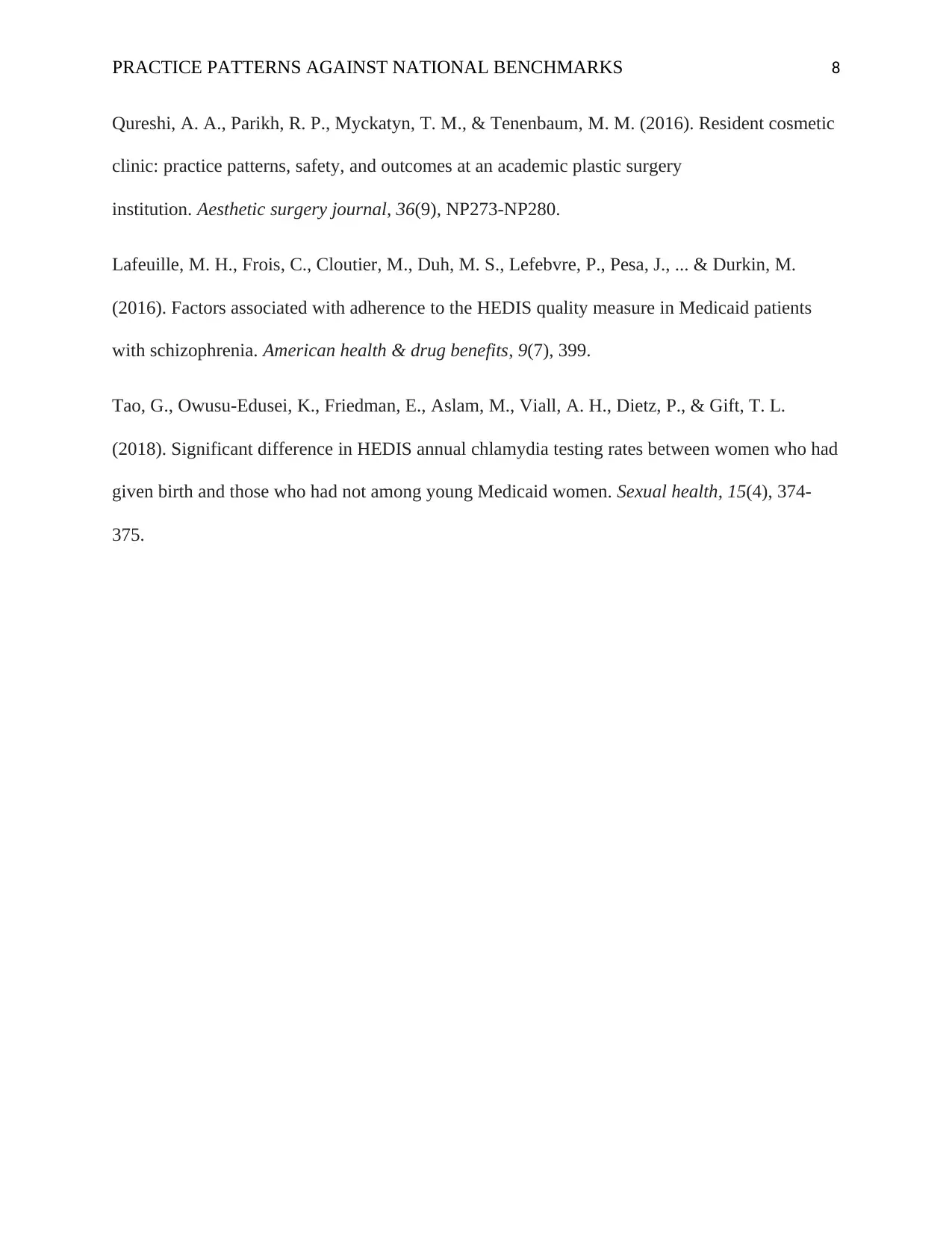
PRACTICE PATTERNS AGAINST NATIONAL BENCHMARKS 8
Qureshi, A. A., Parikh, R. P., Myckatyn, T. M., & Tenenbaum, M. M. (2016). Resident cosmetic
clinic: practice patterns, safety, and outcomes at an academic plastic surgery
institution. Aesthetic surgery journal, 36(9), NP273-NP280.
Lafeuille, M. H., Frois, C., Cloutier, M., Duh, M. S., Lefebvre, P., Pesa, J., ... & Durkin, M.
(2016). Factors associated with adherence to the HEDIS quality measure in Medicaid patients
with schizophrenia. American health & drug benefits, 9(7), 399.
Tao, G., Owusu-Edusei, K., Friedman, E., Aslam, M., Viall, A. H., Dietz, P., & Gift, T. L.
(2018). Significant difference in HEDIS annual chlamydia testing rates between women who had
given birth and those who had not among young Medicaid women. Sexual health, 15(4), 374-
375.
Qureshi, A. A., Parikh, R. P., Myckatyn, T. M., & Tenenbaum, M. M. (2016). Resident cosmetic
clinic: practice patterns, safety, and outcomes at an academic plastic surgery
institution. Aesthetic surgery journal, 36(9), NP273-NP280.
Lafeuille, M. H., Frois, C., Cloutier, M., Duh, M. S., Lefebvre, P., Pesa, J., ... & Durkin, M.
(2016). Factors associated with adherence to the HEDIS quality measure in Medicaid patients
with schizophrenia. American health & drug benefits, 9(7), 399.
Tao, G., Owusu-Edusei, K., Friedman, E., Aslam, M., Viall, A. H., Dietz, P., & Gift, T. L.
(2018). Significant difference in HEDIS annual chlamydia testing rates between women who had
given birth and those who had not among young Medicaid women. Sexual health, 15(4), 374-
375.
1 out of 8
Related Documents
Your All-in-One AI-Powered Toolkit for Academic Success.
+13062052269
info@desklib.com
Available 24*7 on WhatsApp / Email
![[object Object]](/_next/static/media/star-bottom.7253800d.svg)
Unlock your academic potential
Copyright © 2020–2025 A2Z Services. All Rights Reserved. Developed and managed by ZUCOL.





